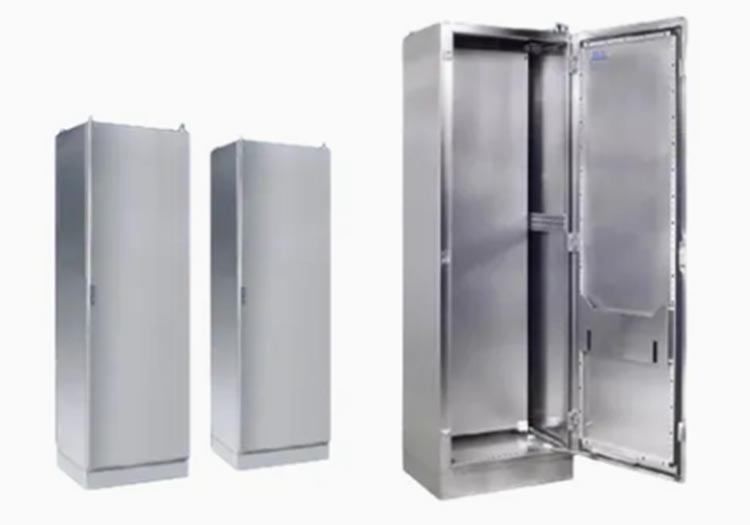
Cold rolled steel enclosure: The base material is low-carbon cold-rolled steel (such as SPCC, Q235), with low carbon content and no anti-rust alloy elements. Rust prevention is achieved through external coatings (epoxy resin spray painting, hot-dip galvanizing, etc.). The coating thickness needs to reach 60-80 μm to form the basic protection, and the coating is the only barrier - once damaged by impact or wear, the exposed steel will quickly react with oxygen and moisture to rust, and cannot self-repair.
Stainless steel enclosure: The base material is alloy steel containing chromium≥10.5% (mainstream 304, 316L), 304 contains 18% chromium + 8% nickel, 316L additionally contains molybdenum element. The chromium element forms an oxide chromium passivation film on the surface, which is dense and can "self-repair" (rapid reaction of chromium elements around the scratch to form a new film), and rust prevention can be achieved for a long time without relying on coatings, and nickel and molybdenum can also enhance toughness and corrosion resistance.
(1) Corrosion resistance ability
Cold rolled steel enclosure: Corrosion resistance is completely dependent on the coating, with significant limitations. It can remain rust-free for 3-5 years in dry environments; in humid and dusty environments, rust spots may appear within 1-2 years, and the rust streaks will spread under the coating; the neutral salt spray test lasts only 200-500 hours, unable to withstand coastal salt spray, industrial weak acids, and outdoor use after 6-12 months, the coating is prone to aging and cracking.
Stainless steel enclosure: Corrosion resistance ability stems from the material itself. 304 stainless steel has a salt spray test duration of 1000-2000 hours, able to withstand outdoor rain and indoor high humidity; 316L due to the molybdenum element, has a salt spray test duration of over 5000 hours, able to withstand coastal salt spray, industrial weak acids, and even short-term immersion in fresh water, suitable for extreme corrosion scenarios.
(2) Mechanical and temperature-humidity compatibility
Cold rolled steel enclosure: The hardness is slightly higher (HV 180-220), but it is prone to cracking at low temperatures (<-10℃), with a maximum temperature limit of ≤ 180℃ (overheated coating will soften); ultraviolet radiation accelerates coating aging, causing discoloration and powdering.
Stainless steel enclosure: The toughness is better (304 impact toughness αk ≥ 40J/cm²), still resistant to impact at -40℃; the temperature range is wide (304 can be - 270℃~300℃), without coating softening issues, ultraviolet radiation will not cause aging or deformation, and the surface gloss is stable.

Cold-rolled steel enclosure: Regular maintenance is required. Dry indoor environments can remain rust-free for 3-5 years; in humid / semi-outdoor environments, rust spots may appear within 1-2 years, and the rust streaks will spread under the coating; the salt spray test only lasts 200-500 hours, unable to withstand coastal salt spray, industrial weak acids, and outdoor use after 6-12 months, the coating is prone to aging and cracking.
Stainless steel enclosure: Maintenance requirements are extremely low. Indoor environments only need occasional dust removal, outdoor environments are cleaned once a year with water + neutral cleaner, no need for re-coating, rust removal, or aging. The service life is much longer than cold-rolled steel, 304 can normally last 15-20 years, 316L due to stronger corrosion resistance, the service life exceeds 25-30 years.
Cold rolled steel enclosure: Suitable for dry, low-corrosion, short-term use scenarios. Such as office building distribution boxes, computer room cabinets, indoor production line control boxes; temporary distribution cabinets for construction, temporary equipment shells for exhibitions, etc., short-term projects; custom color indoor scenarios (spray painting can achieve RAL color card customization, suitable for decoration styles).
Stainless steel enclosure: Suitable for outdoor, harsh environments, and long-term use scenarios. Such as outdoor lighting control boxes, 5G base station cabinets, photovoltaic inverter shells; equipment cabinets in coastal / chemical areas, food processing workshop shells (corrosion resistance); Medical equipment, semiconductor control boxes (long-term protection is required for high-value equipment); food/pharmaceutical industry (smooth surface for easy cleaning, in line with hygiene standards).